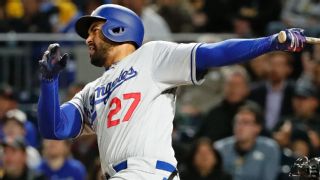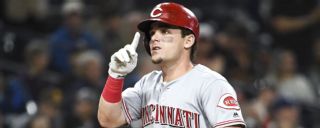|
MLB leaderboards are fascinating this time of year. It's too late to completely write off anything surprising as a small-sample-size fluke, but also too early to believe something will hold up just because it's happening now. There are surprising players mixed in among the usual suspects, big names doing even better than you might realize and veterans bouncing back with eye-popping numbers. Here are some things that jump out from the leaderboards right now: Mike Trout, No. 1 in majors with 23 home runs After slugging four home runs the past two games at Safeco Field, Trout is on pace for 55 home runs, well above his previous career high of 41 in 2015. Of course, he hit 33 in 114 games last season, a pace of 47 over 162 games. Can he keep it going? There's nothing in the numbers that screams fluke. His home run to fly ball rate is a career high, but it's only 2.1 percent higher than last season. That rate ranks 12th in the majors, but nobody doubts Trout's power. His chase rate is also at a career low, allowing him to zero in on those pitches he can crush. This looks like his Mickey Mantle 1956 season. Really, the only thing that might slow him down is if pitchers stop pitching to him (and he's already on pace for 129 walks).
Scooter Gennett, No. 2 in NL with .339 average, 47 RBIs From the "you probably didn't know this" file: Over his past 160 games -- starting with his four-homer game last year -- Gennett is hitting .318/.362/.555 with 36 home runs and 124 RBIs. In fact, since that game on June 6, 2017, Gennett ranks fourth in the majors in batting average, 17th in home runs and sixth in RBIs. That's a long stretch of elite hitting. Gennett's improvement can be traced to a swing change that began in his final season with the Brewers, adding more loft and improving his exit velocity. He also has become more patient. While still aggressive, his chase rate is down 10 percent from his 41.3 percent chase rate in 2015. It's amazing how much you can improve when you swing at strikes. A huge key this season is he's hitting .348/.366/.594 against lefties (up from .248/.287/.404 last year). That's not going to keep up as he has a .455 BABIP against southpaws, so you can expect the batting average to drop, but the 25-homer power appears legit -- making him a valuable trade piece if the Reds decide to deal him and call up Nick Senzel.
 Matt Kemp, No. 3 in NL with .333 average, .556 slugging percentage Kemp in 2011, when he finished second in the NL MVP vote: .324/.399/.586 Kemp in 2018, when he wasn't expected to even be on the Dodgers: .333/.366/.556 It's easy to point to Kemp's .396 BABIP and yell "Fluke!" but some of the deeper numbers actually point to a hitter who deserves the kind of numbers Kemp has produced. According to Statcast data, Kemp's expected wOBA is .409; it's actually at .397. His average exit velocity is up from 2017 (88.3 mph to 91.1), his average launch angle is way up (8.2 degrees to 15.4) and his chase rate is the best it has been since 2014. Look, the BABIP is going to drop, even if he keeps hitting the ball hard, so the .333 average is going to drop. But the biggest factors here are probably the unknown: Kemp's health, motivation and focus, all things that haven't always been there in recent seasons.
Andrew Benintendi, No. 10 in majors with .937 OPS Benintendi's rookie season in 2017 was certainly very good for a 22-year-old, hitting .271/.352/.424 with 20 home runs, but the expectations were so high that it felt a little underwhelming. Maybe we were just a little ahead of ourselves. Benintendi has been overshadowed by Mookie Betts and J.D. Martinez, but he's hitting .297/.383/.554 with 12 home runs and 18 doubles (plus five triples), putting him on pace for 29, 43 and 12. Given his prospect pedigree, I'm all-in. He had a strong approach even as a rookie -- note the 70 walks -- and he has maintained that this season, with similar chase and swing-and-miss rates. He doesn't have elite exit velocity, but it's up a bit (87.1 mph to 88.2), and the added power suggests he's probably a little stronger this year. Indeed, he has been turning on inside pitches with much more authority than last season. His numbers on pitches on the inner third of the plate: 2017: .238/.381/.446, 23.8 percent K rate 2018: .343/.432/.757, 9.9 percent K rate The one red flag is he has outperformed his expected wOBA by nearly 30 points (he's also hitting just .211 against lefties). Still, the improvements seem real and while I'd expect some decline, he looks like a top-20 hitter given his OBP ability and improved power.
Blake Snell, No. 5 in AL with 2.30 ERA Buy your Blake Snell stock. He has always been a favorite of scouts and started to put everything together in the second half last season. Really, all you need to know is his walk rate per nine innings: 2016: 5.2 2017: 4.1 2017 second half: 2.9 2018: 2.7 Batters have hit just .189 against him, including .089 against his slider. His curveball and slider are both dominant putaway pitches, with strikeout rates over 50 percent in plate appearances ending with those pitches. That has helped him to the 11th-best swing-and-miss rate among qualified starters. Bottom line: He's this good. Maybe not quite as good as the 2.30 ERA -- the BABIP may inflate a little and the 85 percent strand rate is high -- plus he may have several starts left against the Red Sox and Yankees, but this kid looks like he'll be representing the Rays at the All-Star Game.
Jon Lester, No. 4 in NL with 2.22 ERA Does this surprise you? I mean, it shouldn't be a surprise that a pitcher of Lester's caliber could reel off a 2.22 ERA over 13 starts. On the other hand, he's 34 and coming off a 4.33 ERA, so this wasn't exactly expected. One thing about his 2017: He had an especially high number of blow-up starts: 6 ER in 3.1 IP, 4 ER (and 10 R) in 0.2 IP, 7 ER in 1.2 IP, 7 ER in 4.1 IP. That's a 21.60 ERA in those four games; it was 3.32 in the other 28 starts. It has been a weird season for the Cubs pitching staff. As Joe Sheehan pointed out Tuesday, the Cubs' walk rate entering Tuesday (11.2 percent) would be the highest since the 2000 Brewers. Yet they're second in the majors in ERA. The gap between their actual ERA and their FIP (fielding independent ERA) of 0.82 would be the second highest ever. As it did in 2016, the Cubs' defense turns a lot of balls in play into outs, although some credit goes to the staff for inducing soft contact as well. Effectively wild. Anyway, that's what has happened with Lester so far. His FIP is actually almost identical to last year (3.99 compared with 4.10). Last year, the balls fell for hits; this year, they're being turned into outs. Check out this comparison: Lester: 21.2% SO rate, 8.7% BB rate, 2.6% HR rate, .241 BABIP, 2.22 ERA Zack Wheeler: 21.1% SO rate, 8.6% BB rate, 2.6% HR rate, .323 BABIP, 4.98 ERA Look, it's not as simple as good luck versus bad luck, or good defense versus bad defense. Lester has years of pitching knowledge and understanding situations and setting up hitters to feed his success. Still, the deep dive suggests some decline is in order.
Edwin Diaz, No. 1 in majors with 25 saves The saves leader isn't always the best reliever or biggest name -- Alex Colome led the majors last season (by six saves!) -- but Diaz has certainly been dominant, ranking second to Josh Hader in strikeouts while holding batters to a .152 average. What might be surprising is that he's on pace for 60 saves, just short of Francisco Rodriguez's single-season mark of 62. That's all good. This maybe isn't: Diaz is on pace to pitch 87 games and 87 innings. He's tied with Bryan Shaw for the MLB lead in appearances, although he has been so dominant that he ranks just 22nd among relievers in batters faced. Still, that's a heavy workload for this era. Trouble is, the Mariners keep playing one-run games (30 of them, most in the majors) and forcing Scott Servais to use his big weapon (although using him for a third straight day Tuesday with a three-run lead didn't seem the wisest of decisions). Can Diaz continue to strike out 42 percent of the batters he faces? Sure. Will he challenge K-Rod's saves record? I expect not. Servais now has Colome in the bullpen, and once Juan Nicasio and Nick Vincent return from the DL he can go back to using them as trusted setup guys and Colome as a ninth-inning option when needed to give a Diaz a rest.
|


